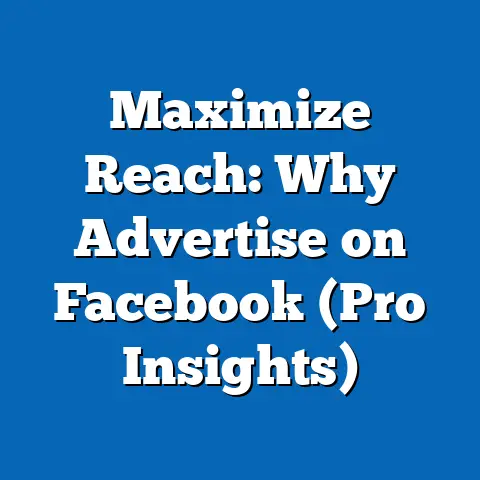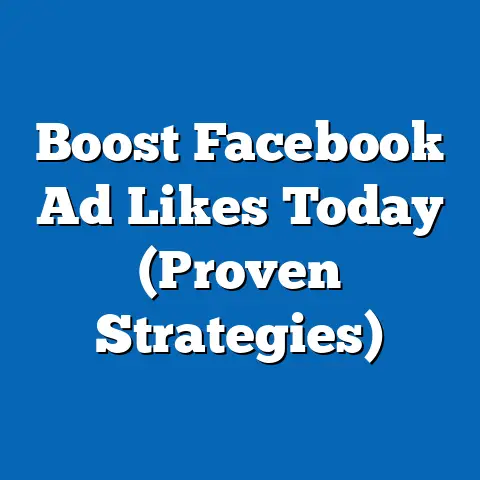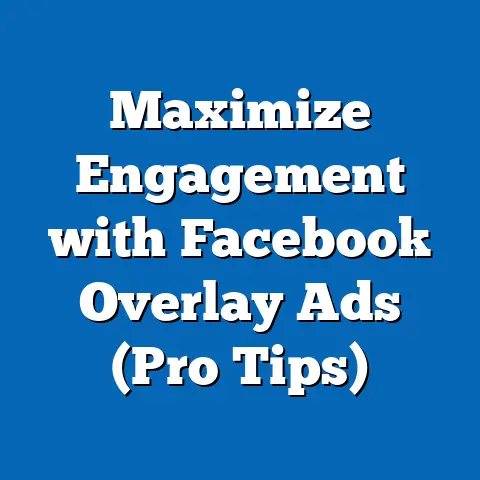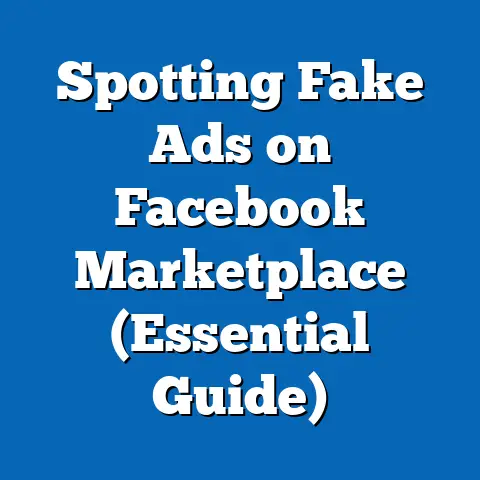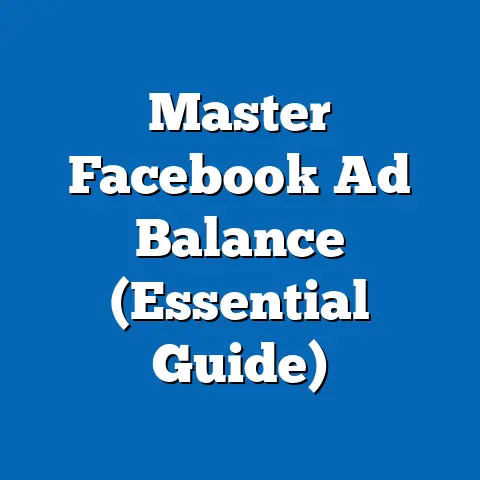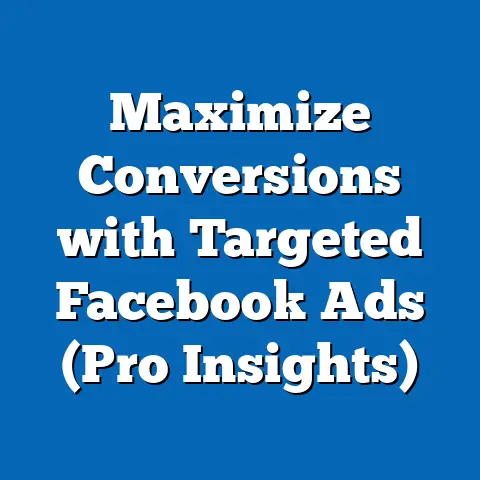Understanding fb ad Set Names (Essential Guide for Marketers)
I remember the early days of social media marketing like it was yesterday. It was a wild west, a digital frontier where we were all pioneers, tentatively stepping into uncharted territory. Facebook was still relatively new, and the idea of advertising on it was both exciting and a little daunting. I recall the thrill of launching my first ad campaign, carefully crafting the copy, selecting the perfect image, and holding my breath as I hit “publish.”
Ad set names? Back then, they were often an afterthought. “Ad Set 1,” “Ad Set 2,” “New Ad Set” – these were the common culprits. As campaigns grew more complex, this lack of organization quickly became a nightmare. Budgets were misallocated, performance tracking was a mess, and I often found myself scratching my head, wondering which ad set was targeting which audience.
It was a hard lesson learned, but it taught me the importance of organization in a marketer’s journey. And that’s where ad set names came in. They were the key to unlocking clarity and control in the chaotic world of Facebook advertising.
In this guide, I’ll take you on a deep dive into the world of Facebook ad set names. I’ll explain why they matter, how to create effective naming conventions, common pitfalls to avoid, and advanced strategies to take your organization to the next level. Whether you’re a seasoned pro or just starting out, this guide will give you the tools you need to master the art of ad set naming and unlock the full potential of your Facebook ad campaigns.
Section 1: What Are Facebook Ad Sets?
Before we dive into the art of naming, let’s make sure we’re all on the same page about what Facebook ad sets actually are. In the grand scheme of Facebook advertising, the ad set is a crucial middleman, bridging the gap between your overarching campaign goals and the individual ads that your audience sees.
Think of it this way: your Facebook advertising structure is like a well-organized filing cabinet. At the top level, you have the Campaign. This is where you define your overall objective – what you want to achieve with your advertising efforts. Are you looking to drive website traffic, generate leads, increase brand awareness, or boost sales? Your campaign objective sets the tone for everything else.
Next, you have the Ad Set. This is where things get more granular. The ad set is essentially a container that holds your targeting, budget, schedule, and placement settings. It’s where you define who you want to reach, how much you’re willing to spend, when you want your ads to run, and where you want them to appear (e.g., Facebook feed, Instagram stories, Audience Network).
Finally, you have the Ad. This is the creative element – the actual image, video, or text that your audience sees. You can have multiple ads within a single ad set, allowing you to test different creative variations to see what resonates best with your target audience.
Here’s a simple breakdown of the hierarchy:
- Campaign: Overall objective (e.g., Website Traffic)
- Ad Set: Targeting, budget, schedule, placement (e.g., Women 25-34 in New York, $20/day, Facebook Feed)
- Ad: Creative content (e.g., Image ad with a specific headline and description)
The Purpose of Ad Sets:
Ad sets serve several critical purposes in your Facebook advertising strategy:
- Audience Targeting: This is perhaps the most important function of an ad set. You define your ideal customer based on demographics (age, gender, location), interests, behaviors, and more. Facebook’s powerful targeting options allow you to reach a highly specific audience, ensuring that your ads are seen by the people who are most likely to be interested in your products or services.
- Budget Allocation: You allocate a specific budget to each ad set. This allows you to control how much you’re spending on different audience segments or targeting strategies. For example, you might allocate a larger budget to an ad set targeting your most valuable customer segment.
- Scheduling: You can set a start and end date for your ad set, or choose to run it continuously. This allows you to tailor your advertising schedule to specific events, promotions, or seasonal trends.
- Placement: You choose where you want your ads to appear. This could be the Facebook feed, Instagram feed, Instagram Stories, Audience Network, or a combination of these placements.
Takeaway: Understanding the role of ad sets within the Facebook advertising hierarchy is crucial for effective campaign management. Ad sets allow you to target specific audiences, allocate budgets, schedule your ads, and choose your placements, giving you granular control over your advertising efforts.
Section 2: The Importance of Ad Set Names
Now that we understand what ad sets are, let’s talk about why their names matter. It might seem like a small detail, but trust me, a well-thought-out ad set naming convention can make a world of difference in your campaign organization and efficiency.
Imagine you’re running multiple Facebook ad campaigns simultaneously, each with several ad sets targeting different audiences and using different strategies. Without a clear and descriptive naming system, your Ads Manager can quickly become a confusing mess. You’ll be scrolling through a long list of “Ad Set 1,” “Ad Set 2,” and “New Ad Set,” struggling to remember which one is targeting which audience, what the budget is, and what the overall goal is.
Why Clear and Descriptive Naming Matters:
- Easier Management: Clear and descriptive ad set names make it easy to quickly identify the purpose and parameters of each ad set. You can glance at the name and immediately understand who you’re targeting, what your budget is, and what your overall goal is. This saves you time and reduces the risk of errors.
- Improved Optimization: When you can easily identify your ad sets, you can quickly analyze their performance and make informed optimization decisions. You can see which audiences are responding best to your ads, which placements are driving the most conversions, and which strategies are delivering the best ROI.
- Reduced Confusion: A well-defined naming convention eliminates confusion and ensures that everyone on your team is on the same page. This is especially important if you’re working with multiple team members or agencies.
- Better Budget Allocation: Clear ad set names make it easier to allocate your budget effectively. You can quickly identify your top-performing ad sets and allocate more budget to them, while reducing budget for underperforming ad sets.
- Simplified Reporting: When your ad sets are named clearly and consistently, it’s much easier to generate accurate and insightful reports. You can easily segment your data by audience, placement, or strategy, and gain a deeper understanding of your campaign performance.
The Pitfalls of Poor Naming Conventions:
On the other hand, poor naming conventions can lead to a host of problems:
- Confusion and Frustration: Scrolling through a long list of generic ad set names is frustrating and time-consuming. It makes it difficult to find the ad sets you’re looking for and increases the risk of making mistakes.
- Misallocation of Budgets: Without clear ad set names, it’s easy to misallocate your budget, spending money on underperforming ad sets instead of your top performers.
- Difficulty in Performance Tracking: Poor naming conventions make it difficult to track the performance of your ad sets. You’ll struggle to identify which strategies are working and which ones aren’t, making it difficult to optimize your campaigns.
- Wasted Time and Resources: Ultimately, poor naming conventions lead to wasted time and resources. You’ll spend more time trying to manage your campaigns and less time focusing on strategic initiatives.
My Experience:
I learned the hard way about the importance of ad set naming. In one of my early campaigns, I used generic names like “Ad Set 1” and “Ad Set 2.” As the campaign grew and I added more ad sets, I quickly lost track of what each one was doing. I ended up misallocating my budget, targeting the wrong audiences, and making a mess of my reporting. It was a costly mistake, but it taught me a valuable lesson about the importance of organization and clear communication.
Takeaway: Ad set names are more than just labels. They’re a critical tool for organizing, managing, and optimizing your Facebook ad campaigns. Clear and descriptive naming conventions can save you time, reduce confusion, improve budget allocation, and simplify reporting.
Section 3: Best Practices for Naming Facebook Ad Sets
Now that you understand the importance of ad set names, let’s dive into some best practices for creating effective naming conventions. The goal is to create names that are clear, descriptive, and consistent, allowing you to quickly identify the purpose and parameters of each ad set.
-
Be Descriptive: The most important thing is to include key details about the ad set. This could include the target audience, geographic location, campaign objective, placement, or any other relevant information.
- Target Audience: Specify the demographics, interests, or behaviors of your target audience. For example, “Women 25-34 Interested in Yoga” or “Lookalike Audience – Website Visitors.”
- Geographic Location: Include the geographic location you’re targeting. For example, “New York City” or “United States.”
- Campaign Objective: Briefly mention the campaign objective. For example, “Website Traffic” or “Lead Generation.”
- Placement: Specify the placement you’re using. For example, “Facebook Feed” or “Instagram Stories.”
-
Include Dates and Versions: Adding dates to your ad set names can help you track the evolution of your campaigns and performance over time. You can also use versions to indicate different iterations of your ad sets.
-
Dates: Use the date to indicate when the ad set was launched. For example, “July 2024” or “07-15-2024.”
- Versions: Use versions to indicate different iterations of your ad set. For example, “V1” or “Version 2.”
-
Use Consistent Naming Conventions: This is crucial for maintaining clarity and organization across all your campaigns. Develop a standardized format for your ad set names and stick to it consistently.
-
Example Format:
[Target Audience] - [Geographic Location] - [Campaign Objective] - [Placement] - [Date] - [Version] - Example Ad Set Name:
Women 25-34 - New York City - Website Traffic - Facebook Feed - July 2024 - V1
Be Descriptive: The most important thing is to include key details about the ad set. This could include the target audience, geographic location, campaign objective, placement, or any other relevant information.
- Target Audience: Specify the demographics, interests, or behaviors of your target audience. For example, “Women 25-34 Interested in Yoga” or “Lookalike Audience – Website Visitors.”
- Geographic Location: Include the geographic location you’re targeting. For example, “New York City” or “United States.”
- Campaign Objective: Briefly mention the campaign objective. For example, “Website Traffic” or “Lead Generation.”
- Placement: Specify the placement you’re using. For example, “Facebook Feed” or “Instagram Stories.”
-
Include Dates and Versions: Adding dates to your ad set names can help you track the evolution of your campaigns and performance over time. You can also use versions to indicate different iterations of your ad sets.
-
Dates: Use the date to indicate when the ad set was launched. For example, “July 2024” or “07-15-2024.”
- Versions: Use versions to indicate different iterations of your ad set. For example, “V1” or “Version 2.”
-
Use Consistent Naming Conventions: This is crucial for maintaining clarity and organization across all your campaigns. Develop a standardized format for your ad set names and stick to it consistently.
-
Example Format:
[Target Audience] - [Geographic Location] - [Campaign Objective] - [Placement] - [Date] - [Version] - Example Ad Set Name:
Women 25-34 - New York City - Website Traffic - Facebook Feed - July 2024 - V1
Include Dates and Versions: Adding dates to your ad set names can help you track the evolution of your campaigns and performance over time. You can also use versions to indicate different iterations of your ad sets.
Dates: Use the date to indicate when the ad set was launched. For example, “July 2024” or “07-15-2024.”
Use Consistent Naming Conventions: This is crucial for maintaining clarity and organization across all your campaigns. Develop a standardized format for your ad set names and stick to it consistently.
Example Format: [Target Audience] - [Geographic Location] - [Campaign Objective] - [Placement] - [Date] - [Version]
Examples of Effective vs. Ineffective Ad Set Names:
| Ineffective Ad Set Name | Effective Ad Set Name | Why It’s Effective |
|---|---|---|
| Ad Set 1 | Women 25-34 – NYC – Website Traffic – FB Feed – 07/2024 – V1 | Clearly identifies the target audience (Women 25-34), geographic location (NYC), campaign objective (Website Traffic), placement (Facebook Feed), date (07/2024), and version (V1). |
| New Ad Set | Lookalike Audience (Website Visitors) – US – Lead Generation – Instagram Stories | Clearly identifies the target audience (Lookalike Audience based on Website Visitors), geographic location (US), campaign objective (Lead Generation), and placement (Instagram Stories). |
| Campaign A | Men 18-24 – California – Brand Awareness – Facebook & Instagram – Q3 2024 | Clearly identifies the target audience (Men 18-24), geographic location (California), campaign objective (Brand Awareness), placement (Facebook & Instagram), and time period (Q3 2024). |
| Ad Set Test | Retargeting – Website Visitors – All Locations – Sales – Facebook Feed – Current | Clearly identifies the target audience (Retargeting Website Visitors), geographic location (All Locations), campaign objective (Sales), and placement (Facebook Feed). The term “Current” might be used to indicate that this ad set is currently active and being optimized. |
| My Ad Set | Custom Audience (Email List) – UK – App Installs – Mobile App – August 2024 | Clearly identifies the target audience (Custom Audience based on Email List), geographic location (UK), campaign objective (App Installs), platform (Mobile App), and date (August 2024). |
| Ineffective Ad Set Name | Effective Ad Set Name | Why It’s Effective |
|---|---|---|
| Ad Set 1 | Women 25-34 – NYC – Website Traffic – FB Feed – 07/2024 – V1 | Clearly identifies the target audience (Women 25-34), geographic location (NYC), campaign objective (Website Traffic), placement (Facebook Feed), date (07/2024), and version (V1). |
| New Ad Set | Lookalike Audience (Website Visitors) – US – Lead Generation – Instagram Stories | Clearly identifies the target audience (Lookalike Audience based on Website Visitors), geographic location (US), campaign objective (Lead Generation), and placement (Instagram Stories). |
| Campaign A | Men 18-24 – California – Brand Awareness – Facebook & Instagram – Q3 2024 | Clearly identifies the target audience (Men 18-24), geographic location (California), campaign objective (Brand Awareness), placement (Facebook & Instagram), and time period (Q3 2024). |
| Ad Set Test | Retargeting – Website Visitors – All Locations – Sales – Facebook Feed – Current | Clearly identifies the target audience (Retargeting Website Visitors), geographic location (All Locations), campaign objective (Sales), and placement (Facebook Feed). The term “Current” might be used to indicate that this ad set is currently active and being optimized. |
| My Ad Set | Custom Audience (Email List) – UK – App Installs – Mobile App – August 2024 | Clearly identifies the target audience (Custom Audience based on Email List), geographic location (UK), campaign objective (App Installs), platform (Mobile App), and date (August 2024). |
Tips for Creating Effective Ad Set Names:
- Keep it Concise: While you want to be descriptive, avoid making your ad set names too long or cumbersome. Aim for a balance between clarity and brevity.
- Use Abbreviations: If necessary, use abbreviations to shorten your ad set names. However, make sure the abbreviations are clear and easily understood. For example, “FB” for Facebook, “IG” for Instagram, “NYC” for New York City.
- Be Consistent: Stick to your chosen naming convention consistently across all your campaigns. This will make it easier to manage and optimize your ads over time.
- Use a Spreadsheet or Document: Create a spreadsheet or document to track your naming conventions and ensure consistency. This can be especially helpful if you’re working with a team.
- Review and Update: Regularly review your naming conventions to ensure they’re still relevant and effective. As your campaigns evolve, you may need to adjust your naming conventions to reflect new strategies or targeting options.
Takeaway: Following these best practices will help you create effective ad set names that are clear, descriptive, and consistent. This will make it easier to manage, optimize, and report on your Facebook ad campaigns.
Section 4: Common Pitfalls to Avoid
Even with the best intentions, it’s easy to fall into common pitfalls when naming your Facebook ad sets. These mistakes can lead to confusion, mismanagement, and ultimately, a less effective advertising strategy. Let’s take a look at some of the most common pitfalls to avoid:
- Vague Names: This is perhaps the most common mistake. Using generic names like “Ad Set 1,” “New Ad Set,” or “Campaign A” provides no information about the purpose or parameters of the ad set. As your campaigns grow, these vague names will quickly become meaningless, making it difficult to manage and optimize your ads.
- Excessive Abbreviations: While abbreviations can be helpful for shortening ad set names, using too many or unclear abbreviations can be confusing. Make sure your abbreviations are easily understood and consistently used across all your campaigns. Avoid using obscure or proprietary abbreviations that only you or a small group of people understand.
- Inconsistent Formats: Using different naming conventions across different campaigns can create a chaotic mess. Stick to a standardized format and use it consistently across all your ad sets. This will make it easier to manage, optimize, and report on your ads over time.
- Lack of Key Information: Failing to include key information about your target audience, geographic location, campaign objective, or placement can make it difficult to understand the purpose of your ad set. Make sure your ad set names include the most important details about your campaign.
- Ignoring Dates and Versions: Dates and versions are crucial for tracking the evolution of your campaigns and performance over time. Failing to include this information can make it difficult to analyze your data and make informed decisions.
- Overly Long Names: While you want to be descriptive, avoid making your ad set names too long or cumbersome. Overly long names can be difficult to read and manage. Aim for a balance between clarity and brevity.
- Neglecting to Update Names: As your campaigns evolve, your ad set names may become outdated or inaccurate. Regularly review your ad set names and update them as needed to reflect changes in your targeting, budget, or strategy.
How These Mistakes Can Lead to Confusion and Mismanagement:
These mistakes can have a significant impact on your advertising efforts:
- Increased Time and Effort: When your ad sets are poorly named, you’ll spend more time trying to manage and optimize your campaigns. You’ll have to click through each ad set to understand its purpose and parameters, which is time-consuming and inefficient.
- Higher Risk of Errors: Poor naming conventions increase the risk of making mistakes. You might accidentally misallocate your budget, target the wrong audience, or make incorrect optimization decisions.
- Inaccurate Reporting: When your ad sets are poorly named, it’s difficult to generate accurate and insightful reports. You won’t be able to easily segment your data by audience, placement, or strategy, making it difficult to understand your campaign performance.
- Reduced ROI: Ultimately, poor naming conventions can lead to a reduced return on investment (ROI). You’ll be spending more time and effort managing your campaigns, making more mistakes, and generating less accurate reports. This can all lead to less effective advertising and a lower ROI.
Suggestions on How to Avoid These Pitfalls:
- Plan Your Naming Conventions in Advance: Before you launch your campaign, take the time to plan your naming conventions. Decide what information you want to include in your ad set names and develop a standardized format that you can use consistently across all your campaigns.
- Use a Template or Guide: Create a template or guide to help you remember your naming conventions. This can be a simple document or spreadsheet that outlines the key information you want to include in your ad set names and the format you want to use.
- Train Your Team: If you’re working with a team, make sure everyone is trained on your naming conventions. This will ensure that everyone is on the same page and that your ad sets are named consistently.
- Regularly Review and Update: Regularly review your ad set names to ensure they’re still accurate and relevant. As your campaigns evolve, you may need to adjust your naming conventions to reflect new strategies or targeting options.
- Use Automation Tools: Consider using automation tools to help you manage your ad set names. Some tools can automatically generate ad set names based on your chosen conventions, saving you time and effort.
Takeaway: Avoiding these common pitfalls will help you create effective ad set names that are clear, descriptive, and consistent. This will make it easier to manage, optimize, and report on your Facebook ad campaigns, ultimately leading to a higher ROI.
Section 5: Leveraging Ad Set Names for Analytics and Reporting
A well-structured ad set naming convention isn’t just about organization; it’s also a powerful tool for enhancing your analytics and reporting efforts. By incorporating key information into your ad set names, you can easily segment your data and gain deeper insights into your campaign performance.
How Well-Structured Ad Set Names Enhance Analytics and Reporting:
- Easy Segmentation: When your ad set names include key information like target audience, geographic location, and campaign objective, you can easily segment your data by these parameters. This allows you to see how different audiences are responding to your ads, which geographic locations are driving the most conversions, and which campaign objectives are delivering the best results.
- Improved Data Visualization: Clear ad set names make it easier to visualize your data. You can create charts and graphs that show the performance of different ad sets, segmented by audience, location, or objective. This allows you to quickly identify trends and patterns in your data.
- Simplified Reporting Process: Well-structured ad set names simplify the reporting process. You can easily generate reports that show the performance of different ad sets, segmented by your chosen parameters. This saves you time and effort and ensures that your reports are accurate and insightful.
- Deeper Insights: By analyzing your data based on your ad set names, you can gain deeper insights into your campaign performance. You can see which audiences are most receptive to your ads, which placements are driving the most conversions, and which strategies are delivering the best ROI. This allows you to make more informed optimization decisions and improve your overall campaign performance.
Utilizing Ad Set Names in Facebook Ads Manager and Third-Party Analytics Tools:
- Facebook Ads Manager: Facebook Ads Manager allows you to filter and sort your ad sets based on their names. You can use this feature to quickly find the ad sets you’re looking for and analyze their performance. You can also create custom reports that segment your data based on your ad set names.
- Third-Party Analytics Tools: Many third-party analytics tools integrate with Facebook Ads Manager and allow you to import your ad set names and data. You can then use these tools to segment your data, create custom reports, and visualize your campaign performance.
Case Studies or Hypothetical Scenarios:
Let’s consider a hypothetical scenario:
You’re running a Facebook ad campaign to promote a new line of organic skincare products. You’ve created four ad sets:
Women 25-34 - NYC - Website Traffic - FB Feed - July 2024 - V1Women 35-44 - LA - Website Traffic - IG Feed - July 2024 - V1Men 25-34 - SF - Website Traffic - FB Feed - July 2024 - V1Men 35-44 - Chicago - Website Traffic - IG Feed - July 2024 - V1
By analyzing the performance of these ad sets, you can gain valuable insights into your target audience and the effectiveness of your advertising strategies.
- Audience Insights: You can compare the performance of the Women 25-34 ad set with the Women 35-44 ad set to see which age group is more receptive to your ads. You can also compare the performance of the Men 25-34 ad set with the Men 35-44 ad set to see which age group is more receptive to your ads.
- Geographic Insights: You can compare the performance of the NYC ad set with the LA, SF, and Chicago ad sets to see which geographic location is driving the most conversions.
- Placement Insights: You can compare the performance of the FB Feed ad sets with the IG Feed ad sets to see which placement is delivering the best results.
By analyzing your data in this way, you can identify your top-performing audiences, locations, and placements, and optimize your campaigns accordingly.
My Experience:
I once worked on a campaign for a fitness app that was targeting different age groups and fitness interests. By incorporating these details into the ad set names, I was able to quickly identify that the 25-34 age group interested in yoga was performing significantly better than the other segments. This allowed me to focus my budget and creative efforts on this top-performing segment, resulting in a significant increase in conversions.
Takeaway: Well-structured ad set names are a valuable tool for enhancing your analytics and reporting efforts. By incorporating key information into your ad set names, you can easily segment your data, gain deeper insights into your campaign performance, and make more informed optimization decisions.
Section 6: Advanced Strategies for Naming Ad Sets
Once you’ve mastered the basics of ad set naming, you can start exploring more advanced strategies to take your organization to the next level. These strategies are designed for marketers who are experienced with Facebook advertising and want to squeeze every last drop of performance out of their campaigns.
Integration of A/B Testing Results into Naming Conventions:
A/B testing is a crucial part of any successful Facebook advertising strategy. By testing different ad variations, targeting options, and bidding strategies, you can identify what works best for your audience and optimize your campaigns accordingly.
You can integrate A/B testing results into your naming conventions to easily track the performance of different variations. For example, you could use the following naming convention:
[Target Audience] - [Geographic Location] - [Campaign Objective] - [Placement] - [Date] - [Version] - [A/B Test Variation]
[A/B Test Variation]could be something like “Headline A” vs. “Headline B” or “Image 1” vs. “Image 2.”
By incorporating A/B testing results into your ad set names, you can easily compare the performance of different variations and identify the winners. This allows you to quickly optimize your campaigns and improve your overall ROI.
Adapting Naming Strategies Based on Seasonal Trends or Product Launches:
Seasonal trends and product launches can have a significant impact on your advertising performance. It’s important to adapt your naming strategies to reflect these changes.
For example, if you’re running a campaign to promote a holiday sale, you could include the holiday name in your ad set names:
[Target Audience] - [Geographic Location] - [Campaign Objective] - [Placement] - [Date] - [Version] - [Holiday]
[Holiday]could be something like “Christmas,” “Black Friday,” or “Summer Sale.”
By incorporating seasonal trends and product launches into your ad set names, you can easily track the performance of your campaigns during these periods and make informed optimization decisions.
Using Dynamic Parameters:
In some cases, you may want to use dynamic parameters in your ad set names. This allows you to automatically update your ad set names based on certain conditions.
For example, you could use a dynamic parameter to automatically update your ad set names based on the current date. This would allow you to easily track the performance of your campaigns over time.
Dynamic parameters are a more advanced technique that requires some technical knowledge. However, they can be a powerful tool for automating your ad set naming and tracking your campaign performance.
My Experience:
I once worked on a campaign for a clothing retailer that was running different promotions throughout the year. By incorporating the promotion name into the ad set names, I was able to easily track the performance of each promotion and identify which ones were driving the most sales. This allowed me to focus my budget and creative efforts on the most effective promotions, resulting in a significant increase in overall revenue.
Takeaway: These advanced strategies can help you take your ad set naming to the next level. By integrating A/B testing results, adapting to seasonal trends and product launches, and using dynamic parameters, you can gain even deeper insights into your campaign performance and optimize your campaigns for maximum ROI.
Section 7: Real-World Examples of Effective Ad Set Names
To further illustrate the power of effective ad set naming, let’s take a look at some real-world examples from successful brands and campaigns. These examples demonstrate how clear, descriptive, and consistent naming conventions can contribute to improved campaign organization, performance tracking, and overall ROI.
Example 1: E-commerce Brand Targeting Specific Customer Segments
- Brand: A fashion e-commerce company targeting different customer segments based on age, interests, and purchase history.
- Ad Set Naming Convention:
[Customer Segment] - [Product Category] - [Campaign Objective] - [Placement] - [Date] - Examples:
Loyal Customers - Dresses - Website Traffic - Facebook Feed - 07/2024New Visitors - Shoes - Conversion - Instagram Stories - 07/2024Abandoned Cart - All Products - Retargeting - Facebook & Instagram - 07/2024
- Why It Works: This naming convention clearly identifies the customer segment being targeted, the product category being promoted, the campaign objective, the placement, and the date. This allows the brand to easily track the performance of each ad set and optimize their campaigns accordingly.
Loyal Customers - Dresses - Website Traffic - Facebook Feed - 07/2024New Visitors - Shoes - Conversion - Instagram Stories - 07/2024Abandoned Cart - All Products - Retargeting - Facebook & Instagram - 07/2024
Example 2: Lead Generation Campaign for a Software Company
- Brand: A software company running a lead generation campaign for a new product.
- Ad Set Naming Convention:
[Target Audience] - [Industry] - [Lead Magnet] - [Placement] - [Date] - Examples:
Marketing Managers - SaaS - Ebook Download - LinkedIn Feed - 07/2024Sales Directors - CRM - Webinar Registration - Facebook Feed - 07/2024CEOs - Enterprise - Free Trial - Instagram Stories - 07/2024
- Why It Works: This naming convention clearly identifies the target audience (job title), the industry, the lead magnet being offered, the placement, and the date. This allows the company to easily track the performance of each ad set and determine which lead magnets are most effective for each target audience.
Marketing Managers - SaaS - Ebook Download - LinkedIn Feed - 07/2024Sales Directors - CRM - Webinar Registration - Facebook Feed - 07/2024CEOs - Enterprise - Free Trial - Instagram Stories - 07/2024
Example 3: Mobile App Install Campaign
- Brand: A mobile app developer running an app install campaign.
- Ad Set Naming Convention:
[Platform] - [Country] - [Device] - [Campaign Objective] - [Date] - Examples:
iOS - US - iPhone - App Installs - 07/2024Android - UK - Samsung Galaxy - App Installs - 07/2024Both - CA - All Devices - App Installs - 07/2024
- Why It Works: This naming convention clearly identifies the platform, country, device, campaign objective, and date. This allows the developer to easily track the performance of each ad set across different platforms, countries, and devices.
iOS - US - iPhone - App Installs - 07/2024Android - UK - Samsung Galaxy - App Installs - 07/2024Both - CA - All Devices - App Installs - 07/2024
Breaking Down the Components:
- Clarity: Each of these examples uses clear and concise language to describe the key parameters of the ad set.
- Creativity: While clarity is paramount, some creativity can be used to make the ad set names more memorable and engaging.
- Organization: The consistent use of a standardized naming convention ensures that all ad sets are organized in a logical and easily accessible manner.
My Experience:
I’ve seen firsthand how effective ad set naming can transform a disorganized campaign into a well-oiled machine. In one particular instance, I worked with a client who was running a complex campaign with dozens of ad sets. The ad sets were named haphazardly, making it nearly impossible to track performance or make informed optimization decisions. By implementing a standardized naming convention, we were able to streamline the campaign, improve performance tracking, and ultimately increase ROI.
Takeaway: These real-world examples demonstrate the power of effective ad set naming. By adopting a clear, descriptive, and consistent naming convention, you can improve campaign organization, performance tracking, and overall ROI.
Conclusion: The Long-Term Benefits of Thoughtful Ad Set Naming
As we’ve explored throughout this guide, thoughtful ad set naming is more than just a best practice; it’s a fundamental building block of successful Facebook advertising. It’s the key to unlocking clarity, control, and efficiency in the often-chaotic world of digital marketing.
In the broader context of digital marketing success, mastering this aspect of Facebook advertising can lead to:
- More Organized Campaigns: Clear and descriptive ad set names make it easier to manage your campaigns, track performance, and make informed optimization decisions.
- Better Performance Tracking: With a well-defined naming convention, you can easily segment your data and gain deeper insights into your campaign performance.
- Improved ROI: By optimizing your campaigns based on data-driven insights, you can improve your overall return on investment (ROI).
- Increased Efficiency: Clear ad set names save you time and effort, allowing you to focus on strategic initiatives and creative innovation.
- Enhanced Team Collaboration: A standardized naming convention ensures that everyone on your team is on the same page, improving communication and collaboration.
I encourage you to take a moment to evaluate your current naming conventions and consider the long-term benefits of implementing the strategies discussed throughout this article. It might seem like a small detail, but trust me, it can make a world of difference in your overall advertising success.
Remember those early days of social media marketing, when we were all just figuring things out? We’ve come a long way since then, and Facebook advertising has evolved into a sophisticated and powerful platform. But even with all the advanced features and targeting options, the fundamentals still matter. And one of the most important fundamentals is the art of thoughtful ad set naming.
Call to Action:
Now it’s your turn! Share your experiences with ad set naming in the comments below. What naming conventions have worked best for you? What challenges have you faced? Or, implement the strategies outlined in this guide in your next campaign and report back on the results. I’m eager to hear your thoughts and experiences. Let’s learn from each other and continue to improve our Facebook advertising skills together!

